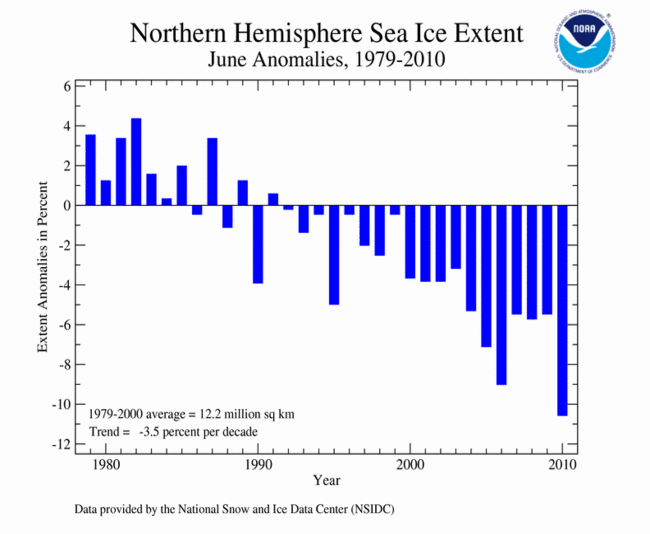
Northern Hemisphere Sea Ice Extent - June 2010
"Arctic sea ice continues to decline at a record rapid rate"
|
Arctic sea ice continued its annual decline, typically reaching a September minimum. Similar to May 2010, the Arctic sea ice continued to decline at a record rapid rate—the fastest measured for June (more than 50 percent greater than average). The previous record for the fastest decline rate in June was set in 1999. According to the National Snow and Ice Data Center (NSIDC), June 2010 Arctic sea ice extent was 10.9 million square kilometers (10.6 percent or 1.29 million square kilometers below the 1979–2000 average), resulting in the lowest June sea ice extent since records began in 1979—the previous June record low was set in 2006. This was also the 19th consecutive June with below-average Arctic sea ice extent. It was reported that sea ice was below average everywhere with the exception of the East Greenland Sea, where sea ice extent was near average. June Arctic sea ice extent has decreased at an average rate of 3.5 percent per decade. Of note, the Arctic dipole (DA) anomaly—an atmospheric pressure pattern—was present during June 2010 (similar to 2007—which had record low September sea ice extent). According to the NSIDC, the DA contributed to the record low sea ice extent observed in September 2007. One of the DA's characteristics is an unusual high pressure over the northern Beaufort Sea (located north of Alaska and northern Canada) and an unusual low pressure over Kara Sea (located north of Siberia). The imbalance in pressure causes winds to blow from the south along the Siberian coast, moving the ice away from the coast, favoring melt. Northerly winds in the Fram Strait region help move the ice out of the Arctic Ocean into the warmer ocean waters of the northern Atlantic. The DA may also favor the import of warm ocean waters from the northern Pacific that will accelerate ice melt. The following graph shows the June Northern Hemisphere Sea Ice Extent from 1979 to 2010. |
